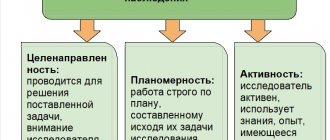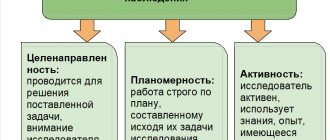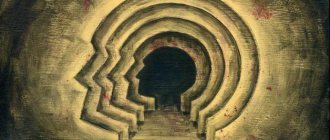Psychological observation: definition of the concept
Observation in psychology is one of the main methods of knowing the characteristics of an object empirically. The method requires a mandatory transition from describing facts to explaining their essence, forming a psychological characteristic of what is being observed.
The results of applying the scientific method can be influenced by the following factors:
- level of knowledge in the area under study;
- professional experience, qualifications of the observer;
- personal experience, emotional and mental stereotypes, value orientations of the psychologist.
Observation presupposes the non-interference of the subject in the process or situation under study.
The method makes it possible to get a complete picture of what is happening and reflect it through records and tables. A special feature of the procedure is the complexity, and often the impossibility, of accurately repeating the observation situation.
The essence of the method
Observation in psychological science, unlike everyday observation, is based on a specific plan, a program thought out in advance, and requires recording facts, their analysis and interpretation.
Only external (speech, motor) manifestations are available for tracking. For example, it is impossible to observe:
- intelligence, but the researcher can monitor the process of solving problems;
- sociability, but you can see the fact of communication with other people.
Observed situations, phenomena, and behavior of objects are necessarily recorded in protocols and diaries. The observed characteristics are presented as descriptively as possible, without explanation. The form of the protocol reflects the subject, task, hypothesis and main criteria of the study.
The reliability of observation results increases if the researcher has the opportunity to use the method for a long time, to observe objects in different situations and roles. The reliability of the study also increases if several observers monitor the situation.
Qualitative observation is only possible if there are no role relationships between object and subject. For example, a schoolchild behaves differently in the presence of parents, teachers and friends. Therefore, the characteristics that different people give it differ.
Psychological observation does not allow the subject to intervene in the situation being studied. The observation results are necessarily supported by data from other research methods.
Code of Ethics
For the proper use and characterization of the observation method, one must follow the basic rules of psychology as established by the Code of Ethics of the American Psychological Association. The researcher must adhere to precautionary measures.
If the trial is carried out in a public place, it is not necessary to obtain the consent of the participants. And for individual research, you need to obtain the subject's permission . Psychologists must behave carefully and try not to harm others. If this cannot be avoided, it is recommended to reduce the damage.
Intrusion into the privacy of participants should also be kept to a minimum. But when observing the behavior of family members, you need to obtain their consent and explain the purpose of the task. If a person engages in self-observation, then he can study any area of his life. All data about the subjects remains confidential, psychologists have no right to disclose them. Only the results obtained can be published without indicating names, addresses and other personal information.
Observation stages:
- object selection;
- data registration;
- creating a plan;
- selection of information processing method;
- carrying out the procedure itself;
- interpretation of data.
At the first stage, the psychologist selects the object and subject, the time and place of observation. He then selects the most appropriate research method and records all the data. After planning and choosing processing methods, he proceeds directly to the observation itself. The results obtained are interpreted to produce a report.
Object and surveillance equipment
The objects of observation are individual people or many participants at once. They may belong to the same or different social groups. The subject of observation is the behavior of those being watched:
- verbal manifestations - content of conversations, intensity, duration of speech, expressiveness, vocabulary, grammatical structures;
- non-verbal manifestations - facial expression, direction of gaze, eye movements, facial expressions, gestures;
- movement - maintaining or not maintaining a distance, speed of movement or state of immobility;
- physical influence on others - blows, pushes, touches, joint efforts.
Only that which can be registered becomes the object of observation. While tracking an object, the researcher does not observe his own mental reality, but records those facts that he sees and can record. The psyche is manifested in behavior - this postulate allows the researcher to make assumptions about the mental properties of an object. The basis for the hypothesis is observational data.
The means of observation can be either the researcher himself or the auxiliary elements chosen by him:
- sound recording equipment;
- video and photo camera;
- special observation maps.
The choice of equipment for recording the situation is determined by the conditions in which it is carried out - in an isolated room, in a public place.
Psychological observation: applied classification
In psychology, the observation method is used in cases where the researcher needs to obtain information about the behavior of a specific person or group of people in the most natural conditions for them, without interfering in the situation. The observation itself should not in any way affect the natural development of events.
There are several types of psychological observation:
- laboratory;
- field (in natural life conditions);
- explicit;
- hidden;
- indirect;
- indirect;
- included (open or closed type);
- not included;
- direct;
- indirect;
- solid;
- selective.
During continuous tracking, the researcher records all the nuances and signs of the object’s mental activity over a certain period of time. In selective research, only those manifestations that directly or indirectly relate to the topic being studied are taken into account.
The classification also includes the concept of systematic and non-systematic observation. In the first case, the research is carried out in accordance with a clearly defined plan. The observer records behavioral characteristics, registers and classifies external conditions.
With non-systematic observation, the researcher’s focus is on a generalized picture of the behavior of a subject or group of people in certain external conditions. At the same time, the goal is not to record the causes of behavioral manifestations, analyze their relationship and strictly describe the phenomena.
Field observations are carried out in natural conditions for an object or group. The main requirement is the researcher's non-interference in the situation. Observation in natural conditions makes it possible to study the behavior of an object without significant distortions. But the problem with conducting such research is that it is labor intensive, and also that the researcher cannot control the situation. Field surveillance is often unsystematic and is carried out using a wait-and-see approach.
Laboratory tracking is more convenient for the researcher, but the artificial environment may not have the best effect on the results of the study.
According to the duration of the study, they are distinguished:
- longitudinal - carried out over a long time (several years, decades), involves constant contact between the researcher and the object of study. The result of the observation is recorded in diaries, representing as widely as possible the behavior, lifestyle, habits and other manifestations on the part of the object;
- Periodic is the most common type of chronological tracking structure. It is carried out over several short periods of time.
Single, one-time observations - they are presented as a description of individual cases. Research is unique in nature, but can also be represented by already known manifestations of a psychological process or phenomenon.
Based on the forms of research, a distinction is made between conscious and unconscious, internal and external observations.
Unconscious internal psychological observation
This type of surveillance is characterized by the fact that the target is unaware that he is being monitored. The researcher himself becomes part of the situation. For example, psychologists often infiltrate a specific company in order to study in as much detail as possible the behavioral characteristics of its participants. During the study, the observer comes into close contact with the object or their group, but the subjects are not aware of the purpose of the interaction.
The method of unconscious internal observation is often used to study the characteristics of small social groups. The psychologist's natural behavior contributes to successful research. If this condition is met, work in a group does not affect the course of the study and the behavior of its participants.
Ethical issues can complicate the job. During tracking, difficulties may arise with audio and video recording, especially considering that the recording of the results must occur in secret from the participants.
The observation itself does not influence the subject's behavior as prescribed by the protocol. He receives the maximum amount of useful information if he can establish direct contact with the subjects being studied. But another problem may be that the psychologist begins to share the moral values of the subjects being studied, and the specialist experiences a moral conflict.
Conscious internal psychological observation
Conscious internal observation is characterized by the fact that the subject knows that he is being watched. The researcher comes into contact with the observed, even before starting work, introduces him to the task at hand, and talks about his status.
Sometimes the subject is given incorrect information. This is done to make it possible to record the characteristics of behavior in a specific situation. Such actions by researchers contradict the requirements of the ethical code and threaten serious punishment, and the experiment often has an unfavorable outcome. The situation itself creates stress for the observed, and its consequences can negatively affect his future life.
External type
The main condition for carrying out external unconscious observation is that the observed person does not know that he is being tracked. The psychologist does not come into contact with the object or the group being studied, but only records the information received, being in a detached position.
Thus, doctors in psychiatric clinics monitor patients through a small window. From the doctor's side it is transparent, but the patient sees a mirror instead of a window. This feature of the tracking organization makes it possible to observe the actions of objects without constraining or embarrassing them.
During external observation, it is possible to collect maximum objective information about the object, its behavior or mental manifestations. The advantage of such observation is that a tired researcher can be replaced by another, and it also becomes possible for several specialists to take part in the experiment at once.
In external research, the situation unfolds naturally, without pressure from the outside; the specialist has the opportunity to use technical means to record facts.
Classification of observations.
Observations are classified in sociology according to various aspects:
- According to the degree of formalization of the procedure.
- According to the degree of observer participation in the study.
- At the location of observation
- Judging by the regularity of observations.
Let's look at the types of observations in more detail.
Depending on the degree of formalization, we distinguish between uncontrolled (or non-standard, unstructured) observation and controlled (standardized, structured) observation.
In non-standardized observation, most of the observed elements are not predetermined. This type of observation requires solid theoretical training in the field of sociology, psychology, social psychology and conflict resolution, the ability to observe at least 5-7 parameters of a situation with equal attention, and the ability to quickly switch attention. That is, the researcher uses only a general principle design, according to which the results are recorded in free form directly during observation or later from memory.
Standardized observation, on the other hand, is characterized by clearly formalized procedures and instruments, which, in turn, require the observer to have greater ability to focus on detail and self-control, as well as punctuality, diligence and pedantry. In this case, it is necessary to have a pre-compiled list of events and signs to be observed; definition of conditions and observational situations; instructions for observers; uniform coders for recording observed phenomena.
Depending on the observer's position, a distinction is made between participatory (or participation) observation and simple observation. In the first case, the researcher simulates entering the social environment, adapts to it and analyzes events as if “from the inside.” Participant observation, in turn, can be open or closed. In the open, those being observed are aware of the researcher's presence among them and know the researcher's goals. Such an observer needs the ability to quickly and effectively establish contacts with strangers, sociability, friendliness, tact, restraint and tolerance (compatibility with other people).
Confidential surveillance, which is carried out incognito (covertly), means that the observers know nothing about the observer and think that he is one of them. Here, the observer needs not only the above qualities, but also artistry, the ability to respond to many signals simultaneously, systematize them quickly and remember them for a long time (more precisely, until the completion of the relevant methodological documentation), the ability not to lose a research position under the influence of various circumstances, and to maintain neutrality in conflicts between observers and many other qualities close to those of a scout.
In simple observation, the observer registers events “from outside.” The ideal observer, the non-observer, tries to be invisible. Since this ideal is unattainable, he must behave in such a way that he is noticed as little as possible in order to reduce the disturbance he causes to the observed phenomenon. Bright (pretentious) clothing, extravagant manners, and excessive demonstration of his interest in the events being studied are contraindicated for him. He must have a stable psyche, a phlegmatic temperament, the ability to self-control during sudden changes in the situation, patience and stability in relation to an external observer.
Depending on the conditions of the organization, observations are divided into field (observations in natural conditions) and laboratory (in an experimental situation). These types of observations also place special demands on the professional knowledge and skills of the sociologist, as well as on his personal qualities: Laboratory observation, carried out in artificially created conditions, increases the importance of the researcher’s ability to regulate these conditions and control their influence on the observed, as well as such qualities as adherence to principles and accuracy, technical competence (through the use of audiovisual surveillance). In field observations carried out in ordinary social life and providing more objective information, knowledge of the meaning of people’s non-verbal reactions (smiles, gestures), working memory, analytical thinking of the observer, his ability to distinguish individual features of the object being studied from each other, to distribute his attention to all of them and switch it to one of them, play a special role.
There are also systematic, episodic and random observations (the last two are sometimes summarized by the term "non-systematic").
Random observations, which are not included in the research program and in which the units of observation are not strictly regulated, can become heuristically valuable only if the theoretical thinking, scientific imagination and intuition of the sociologist are well developed.
However, in systematic observation, the purpose of which is regular recording (according to a strict schedule and in clearly regulated methodological documents) of observation units determined not by the observer himself, but by the director of the study, these qualities are not mandatory.
Sociological schools focused on qualitative methods of social research use the observation method as one of the central independent methods. A classic example in sociology is N. Anderson's study of the lives of Chicago hobos through integrative observation. History knows of many other studies of this type, such as Thrasher's study of urban gangs (Chicago, 1928). A relatively recent example of this approach is the study of M. Borovaya, a professor of sociology at the University of California at Berkeley, who spent several years working as a factory worker in various countries (including Russia).
Let's look at one of the classic examples of using participant observation to obtain basic information: the work of William White (1936 - 1939), who introduced this method of observation into scientific practice.
While studying at Harvard University, White settled in the slums of an American city to study the lifestyle of the Italian immigrants living there (he gave the area the name Corneville). Whites were interested in the habits of emigrants who found themselves in a foreign culture, their orientation and relationships. The Clorneville area was known as a dangerous Italian ghetto for outsiders, full of suspicious gangs. White entered the local community, ostensibly a history student who wanted to describe the origins of Clorneville. The researcher examined the specific jargon of the Italian language used in society. For three years he lived side by side with these people, befriending the leaders of two rival groups of con artists and learning about local customs, card games, and the game of ball. He lived with the same immigrant family for 18 months, eventually being accepted as one of them. At first he secretly wrote down his impressions, but as he gained confidence in himself, he did not hesitate to take notes in the most seemingly inappropriate places; everyone was used to seeing him with a notebook in his hand.
Psychological observation: advantages and disadvantages
The advantages and disadvantages of a research method such as observation should be assessed in advance, at the planning stage.
The positive aspects of observation include the opportunity to:
- identify the smallest details of the issue under study, reveal its versatility;
- see and record events and behavioral manifestations directly during their occurrence;
- maintain contact between the observer and the subject, which allows you to obtain the most reliable, objective and relevant information of a social nature;
- fully understand the motives and meaning of certain behavioral manifestations in different situations, identify their impact on current events;
- maintain the researcher’s independence from the observed object, when collecting information, rely not only on the ability, but also the desire to establish contact.
Observation is a relatively inexpensive empirical method. It allows you to quickly obtain the necessary information. The study is easy to organize regardless of the willingness of one or a group of objects to participate in it.
Disadvantages of psychological observation are divided into 2 groups - objective, independent of the observer, and subjective. They are associated with personal characteristics, professional qualities of the researcher, as well as the attitudes of the experiment participants.
The objective disadvantages of observation in psychology include the following:
- the inability to use tracking often enough when it is necessary to involve a large number of people being observed;
- a limited number of studied processes and related mental phenomena, which leads to a narrowing of the ability to widely generalize the results obtained;
- the difficulty, and often impossibility, of completely repeating the study;
- the ability to draw only qualitative, but not quantitative conclusions;
- frequent occurrence of difficulties with recording and describing the phenomena under study, the need to do this part of the work after the end of the observation;
- insufficient opportunity to obtain information about the goals and reasons for recorded behavior;
- temporary limitation on the time of unfolding of the event;
- the labor-intensive nature of the method, often the need to involve a large number of highly qualified specialists in the research;
- high cost in the case of using special sound and video recording equipment.
Psychologists believe that another disadvantage of observation is that the method does not allow one to directly examine all the facts; many areas are inaccessible for research in this way.
Among the subjective disadvantages:
- the researcher's ability to influence the situation;
- the risk of introducing a subjective opinion or attitudes during the interpretation of the received material, which entails an incorrect interpretation, a discrepancy between the obtained result and the real situation;
- unequal social status, cultural differences, dissimilarity in behavioral stereotypes and life positions of the researcher and the subject can affect the interpretation and distort the result;
- The researcher’s personality traits may affect his perception of the observed situation, which reduces the quality and reliability of the method. For example, if a specialist develops a feeling of condescension towards an object, it is possible to obtain an exaggeratedly positive result. If a psychologist is unconsciously inclined to see the contrast of the participants in the experiment, then he can ignore their characteristic character traits and behavioral manifestations and notice only those that coincide with his perception.
At a certain moment, a psychologist can leave the observer’s position and become involved in the situation. This is fraught with the fact that he will lose the opportunity to objectively assess what is happening.
If the researcher, even before the start of the experiment, has a clearly formed opinion regarding the subject of the study, this may cause the formation of a certain point of view on the situation. Expectation often arises if the researcher has had contact with the person being observed before the experiment. In such a situation, a shift in emphasis during observation is possible.
Psychologists may make mistakes during observation. They, like the problems listed above, arise in the absence of personal therapy and supervision from a specialist. The most common mistakes are:
- Averaging is the fear of making an extreme judgment. It is based on the belief that extreme behavioral manifestations are much less common than low- and moderate-intensity ones. Avoiding polar assessments, researchers average them and make the results uniform. Using a wide range of estimates when studying the intensity of behavioral manifestations helps to avoid this. A psychologist prone to averaging needs to identify in himself the reason for excessive indulgence (it can be provoked by self-doubt, poor knowledge of the subject of research).
- Incorrect modeling, in which the researcher uses deduction, is confident that some personality traits are interrelated or contradict each other. Arranging a “logical” conclusion according to the type: a friendly person is good-natured, a good-natured person is trusting or eloquent, an eloquent person is well-educated and educated, an educated person is eloquent, leads to an erroneous result.
The psychologist’s mood during observation can leave an imprint on his perception of the situation, as well as distort the result of the experiment.
The disadvantages of psychological tracking can be overcome by carefully thinking through the program and thoroughly preparing for the work of collecting the necessary information. Monitoring the progress of work by the study organizers also helps to cope with difficulties.
Irina Sherbul
THIRD PARTY SURVEILLANCE
OBSERVING MEETINGS. When concluding a contract for organizational diagnostics, we must warn the client: in order for it to be sufficiently complete, objective, and accurate, it is not enough for us to conduct interviews or analyze decisions; we also need to analyze the interaction of managers and subordinates in their real conditions, and for this we need access to the indicated forms of their interaction. This is a difficult moment, but we must be persistent and argue for the quality of the diagnostic product. Most often, managers agree. We do not participate in the meetings themselves. I usually sit somewhere to the side and don’t even always introduce myself. Everyone understands that since the general has authorized it, it means it has to be done. After some time, immersed in a tense conversation, they forget about the presence of the consultant. What are we looking for at such events?
First of all, we need an answer to the question: does the company have a developed management team? For its signs, see the special chapter on this. It may very well be that in front of us is a rigid pyramid, where everyone sits, facing only one point, and reacts only to sounds and gestures from there. This is not even a meeting, but a briefing report. Having fixed this state of relations at the top level of management, we give ourselves the task: to monitor how this affects the quality and implementation of decisions, the consistency of goals and actions. And if such a dependence is established, we will definitely reflect it in the report, we will put a perpendicular here.
At meetings, we are interested in seeing the degree and nature of participation of subordinates in decision-making by the first leader: are they required to take initiatives, advice, or are they inclined to express them themselves. It is worth noting the ratio of positive and negative impacts, which of them prevails and in which cases. It is important to monitor the content of the decisions - is there an emphasis only on “turnover” or more on the future. The level of conflict in the organization is also noticeable at such meetings. In a word, you need to treat everything that happens at the meeting clinically, analytically, link the facts obtained here into generalizations, compare them with information obtained by other methods.
In observing meetings, more precise techniques can be used, for example, content analysis, that is, recording and counting the use of different terms and expressions, say, the ratio of positive and negative meanings or managerial and technical.
OBSERVATIONS OF COMPETITORS. Nowadays it is customary to hold industry exhibitions almost everywhere. Their value is not always clear, but they are very informative for the participants themselves and for us, consultants. Perhaps such information content is much higher there than marketing opportunities. Moving from box to box, from section to section, the consultant asks company representatives the same questions and compares the answers. For example, I usually ask about the advantages of the demonstrated products, services, about the features of the presented company, about its suppliers, about the quality of raw materials, about the dealer network, about the terms of discounts, about trade credits, etc. Rarely in response do I get asked to introduce myself. If they still ask, I call myself who I am, although I can leave this question unanswered. Obligatory-
but I draw attention to the degree of activity of company representatives in interacting with visitors to their boxes in general, and not just with me. I write down the answers, compare them, then show my client the differences, highlighting the notable cases.
So in the report I get interesting material on the comparative characteristics of the company’s customer orientation, success factors, superior differences, and competitive advantages.
This information can be well supplemented by visiting the offices and sales departments of competitors. For example, conduct negotiations on possible purchases, or even make purchases.










